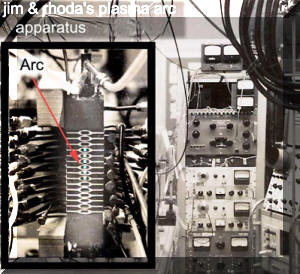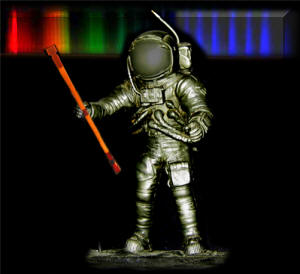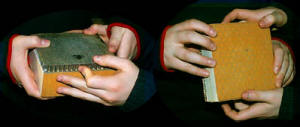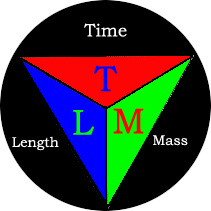|
Our
Galilean Syndrome
Galileo was found
guilty as charged. Recanting the
truth, he was sentenced to life
imprisonment, instead of being
burned to death, his only other
choice. The story shows how little a
scientist 1600 had to do to get into
trouble. Putting two little pieces
of chipped glass in a cardboard
tube, showing people the wonderful
things in the heavens, expanding
our
knowledge. of the world, was enough
to be to jailed for life.
Today
a couple of grams of stem cells and
intentions, or ice cores from the
south pole looking for global
warming can be troublesome to us. At
least in the States we don't use the
fire and stake punishment anymore to
get rid of unwanted science. We pass laws forbidding the unwanted
science some of them carrying
criminal punishment. We get "our"
government officials to reduce or
stop the funding of that unwanted
science.
Basic scientific
research is our future!
There are No Words
Powerful Enough to express the
importance of basic scientific
research, to our past, present, and
future.
Unfortunately there
is evidence that in the U.S.,
students are drifting away from
careers in science, even the rate of
foreign student coming to our
graduate universities to get their
degrees and become citizens has drop by large percentages! There
is lots of data from responsible
sources showing these alarming
trends. For example --In 2004 China
graduated 500,000 engineers, India
200,000 compared to
U.S.70,000 even when taking the per
capita differences its a worrisome
picture. Its encouraging to see the
over all world growth in engineering
and science , But disappointing to
watch high tech U.S. becoming low
tech U.S. ---for more info go
to .
http://pubs.acs.org/cen/coverstory/84/8401president.htmlhtml
Our hope and our goal
is that this very fine, very
beautiful, telescope and its
replica's will motivate us to stop
for a moment, to think and learn about not just the optics with
its very narrow field of view, but
the much larger real image of
Galileo and his world, the world of
scientists and of their science,
their personal, business,
political, and religious worlds; to
reflect on how vulnerable science
and its very small community of
scientists are to the collision
between these power centers
Hopefully this understanding will
help bring about, not just a truce
but, a fusion of all these valuable,
well intentioned, powerful forces
creating an energy of cooperation
between them that will benefit us
all. Basic Science and basic
researchers will always need our
help.
|
These days knowing how natural
science and the basic research scientist fit into
our lives is a life and
death issue to each of us. (DNA......Stem Cells...... Weapons of Mass Destruction------etc.
all directly affect our physical, mental
health and wellbeing).
Galileo, his telescopes/spyglasses with
their 400 year old dramatic story is a bench mark for
comparing
the progress we have made in 400 year for providing a
rational environment for basic research
scientist today! The alarming issue in this
comparison is that in spite of the fact that we have
discovered allot about how we work in the last 400
years and the results of this knowledge has made
our world demonstratively safer (
today's average lifespan
is 80 years compared with 37
years in Galileo's time in technically advanced
nations). We see examples of much of this same knowledge
being miss used in dangerous ways every day
through actions of a tiny fraction of us namely our
leaders.
Most of us have been told that a fanatic few can kill hundred of
thousands to million of us by pushing a single button on a
weapon of mass destruction.
Yet most of us are not in the
constructive action mode and may not really
understand that It is not
what we know about natures secrets but what we do with
this information that is
really important. This knowledge belong to us (the public)
for our use not to our leaders. We need to do
more basic research not less to help us learn
how to stop this non productive circle of madness. The
solution is not to cut back on basic research
leaving us with the same tired old methods, methods
which have been proven time and time again not
to solved any of the problem that we face today but
has continuously lead us to senseless wars with each
other and with the very planet we live on.
So in writing this web site we have asked
ourselves---- is just knowing who invented the telescope
and how it works really important to us?
We think not
-------
But
The
story of Galileo and his telescopes/spyglasses should be
used as a bench mark and teaching tool to show us
how basic research in science works and what needs to be fixed
to make it work better. It would be useful to put this
learning experience of how basic research works
following Galileo's example on the top of our "important
things to do list".
Natural science and scientist need our
help at the funding source. |
The Importance of
replicating Galileo's Telescope.
The only
Telescope in the world with
TWO Significant Images.
Professionals have found
that replicas of Galileo's
beautiful and high quality
telescope, attracts and
holds attention of the those
around it. Galileo used it
in his quest for funding and
recognition. This approach is
alive and well today with an
image sharper than any other
telescope in the world.
Displaying the leather replica,
which one see's in the dramatic
picture above is an excellent
dramatic visual attention
getting tool. The professional
media community whose job is to
get and hold people's attention,
has indorsed it by using our
replica in a number of
their TV programs about science
and famous scientist from
Galileo to Einstein.
This
beautiful leather Galileo's
Telescope is doubly important
because it is one of the few
telescopes in the world that has
two images! The brightness
ratio of the two images is high,
the contrast ratio is very low,
the aberrations of the images
are coupled resulting in
substantial blurring. Many
scientist have not noticed the
second image. Others have
noticed it but not worked on it, leaving us with one of the most
important unsolved problem in
science, The Galilean Syndrome.
Expressed from the personal drama
approach, This telescope plays a
crucial role in teaching
by historical example the
hidden aspects of science, its
business, its politics, the ethical concerns. WE (all of us)
need help in stemming the tide of
the Galilean syndrome.
The picture above with the
telescope in center stage, dressed
in its very best attire is very
beautiful and represents a very
dramatic moment in the science of
1600 and today.
-
There are important issues to
high light when one gets the
audience with the telescope in
front of them!
-
The audience will include those
who love hi tech gadgets but may
be
indifferent to
the scientific details,
-
It probably will
include
the very important tax paying
citizen who pays for most of the
basic scientific research.
-
The audience may only glance at
the telescope a few seconds. at
best a minute of their time.
-
Now could be time to help each
other understand not how the
optics of the Galileo telescope
works (poorly at best) but the
bigger picture of how Our (all
of us) science works. Its goals,
its needs a combined effort to
rid or reduce the consequence of
the Galilean Syndrome.
We
must accept more responsibility to
help us be more aware that both the
scientific community and the public
desperately need each others help.
-
The bottom line message put into
more poetic terms,
-
spoken more eloquently,
-
by one of our famous fallen
sponsors of science,
-
especially of the space program.
Ask not what our science can do for
us, ask what we can do for our
science.
Just
5 minutes of our time calling your
Senators and Representative simply
expressing" We need more support for
basic research" would be very
helpful. Science and scientist need
our help. Go to
Basic scientific research is our
future!
for help, to be more of help, for
our science.
More notes and
additional ways of saying the same thing
Galileo Galilei's Telescopes.
A journal of the project's research
and assembly
by Jim & Rhoda Morris
Introduction
The what, why, and how of this project.
The
What
We have built two of these beautiful instruments. One goes on exhibit at
Griffith Observatory October 2006. The
other served as a prototype and backup during
the building process. Each has nearly 100
parts and over 400 hot gilded stampings. It has
taken upwards 1200 man hours of research and shop
time to build them. Tolerances are within
approximately 1.5 % of the original, most times
closer both inside and outside. In this web page we
go into a detail description of the internal,
external parts of this internationally famous
telescope showing a number surprising building
details not generally known to average
Galilean buff.
Many people have helped us in
this job. The authors thank all of those who helped
with donations of time, material, advice,
encouragement and patience. You all have
done a great job. Your help will be a lasting
contribution to our understanding of the
Pernicious
Galilean Syndrome.
The Why We
Have Spent So Much Effort On Such A Faithful
Replication.
. These
telescopes are symbols or reminders to support basic
scientific research and to avoid becoming a victim of
the Pernicious Galilean Syndrome The
originals have been faithful to the cause, the
replicas cannot be any less faithful. In all
likelihood very few replica's will ever
be built to this precision and with such care and
with the lucky opportunity to be
displayed so openly to the public.. They deserve the
best for the best.
If Galileo's telescopes could talk they would shows
us by example the unproductive, unnecessary quagmire
that science faces as part of its every day work
caused by emotionally based opinions. The TELESCOPES
AND THEIR REPLICAS tell us that 400 years have
passed and we still do not have a satisfactory
solution to this time and resource consuming issue
of ejection of scientific models and discoveries.
When we visit these telescopes or read about them we
should be guided to study them and their story
intellectually. It will remind us that that science
belong to us we still have lots work to do to solve
this problem and that we should get on with it.
HERE IS Real data both good and bad to digest;
In the year of 2004 China graduated 400,000 and India graduated 200,000
engineers while we in the U.S.
we graduated 60,000. China leaders are mostly
engineer and scientist and their is economy
growing at an all time rate and their citizens along
with it. Our government are lawyers sprinkled
with doctors and were are loosing skilled jobs
at a rate unprecedented in our wonderful country
history.
Visit our website for more information.
The Synopsis of
Galileo's and Science's Tragic Story
It is an interesting, true story most of us
can appreciate in our heart and head. The
lessons surrounding these telescopes shows the
dramatic moments of glory and the depths of
frustrations in basic science. The famous Galileo telescopes began their life as weapons of war. They were designed as spy glasses to be used to spy on the enemy at a safe
distance. Galileo traded his rights
of ownership for a raise in salary and a tenure at
his university. Sound familiar? When he turned it to
the sky he discovered that God had made a much larger
universe than the Church and Government was giving God credit for.
This experience in his scientific work was filled
with high drama . He barely
escaped being burned alive at the stake and had to
tell everyone that he was wrong about God having a
more sophisticated universe than the opinions a few
leaders of the Church and Government. Thus having seen the light he was only put under house arrest for the rest of
his life! It is a strong image of major collisions about minor issues that
new discoveries get caught in between powerful forces in
our lives, Religion, Politics, Business, and Science.
The Playing Field of a Struggle That is Not a Game
That all of us player in.
These
telescopes remind us that the voices of
politics, religion, and business have a very
powerful influence over the funding and acceptance
of scientific discoveries even though these power
centers don't have leaders wise or informed enough to have this
responsibility. The voice of
science by comparison is like a whisper in a hurricane. Few of us are permitted to hear directly the cries
for help from the basic scientific research
community even though their discoveries of how
things in nature work are of great benefit to all of
us.
The Irony of it All
Comparison to the trouble they
caused these remarkable and beautiful telescopes are
tiny physically. They weigh less than a pound.
They carry with them two little pieces of
glass, fixed in a skinny home made tube, and
have marginal optics to study the stars,
but by to days standards, 400 hundred years
after their birth, they still give us a
near perfect image of how large the conflicts between the power
centers and science can get and how damaging
they can become.
Galileo's telescopes and their replicas are
steadfast. They may be battered from
their 400 year journey but they continue to
urge each of us to help the
basic researchers with their struggle for increased
funding and decreased the subjectively based political censorship of
their data.
SOS Save Our Science From the Obtuse Mire.
A 3 minute telephone call to
your federal and state congressman passing along a 7
word message (Please increase funding for basic
scientific research) is all you will need to say. Your congress person will understand you
perfectly ----It will help basic research more
than you will ever know. and in the future will help
you. |
About this website
and the Galileo telescope projects
for the Griffith observatory and Adler Planetarium and how
these replicas can help us understand the very important business of
science.
|
This website is about the precise
recreation of these telescopes and presents insight into Galileo as a
Teacher, Basic Research Scientist, Applied Scientist, Engineer and Entrepreneur from the eyes of
two senior level technical observers. We come with experience in experimental basic, applied research, and new product development which has been helpful to us in replicating these instruments. The added experience we gained in building them has given us a useful technical insight into Galileo technical work which we hope will be useful to those who study Galileo and the environment he worked in.
The two rules we used in carrying out this work are.
Rule 1, We sense that these instruments have a significant cultural importance's therefore accuracy in replicating these telescope is important if they are to taken seriously as symbols of Galileo dramatic story, a very powerful, a very important story that all of us need to pay attention to.
Rule 2, We have stayed away from the personalities, the family issues, and the what, where, and when of inventor-ship that some commercial and hobby bio-authors dwell on. There is more than enough data to suggest that Gossipy personal views of Galileo- private life which are mostly guesses trivialize the importance of the Galileo story diverting us from the real issues which are so important to all of us, the vigorous public and political support needed by basic scientific research.
It saddens the authors when we read critical comments about Galileo work from reviewers that have little to no hands on experience in the many roles that Galileo played throughout his technical career. These authors muddy the waters of what science and engineering is all about.
Galileo's telescopes carry with them very important examples of the religious political and commercial trials and tribulations that our scientist have to deal with as part of their daily chores. These extracurricular duties are created by non scientist slowing down the delivery of new valuable scientific discoveries to us by leaders who find it difficult to understand what science is all about. We allow these leaders to slow down and deprive all of us cures for costly debilitating illnesses. They slow down the discoveries that could bring down the cost of just living a healthy satisfying higher quality of life.
Because it is so very important, we have included our concerns for the future of science and its application in this country. We take note of the fantastic increase in life expectancy for humans living in technology-supporting countries and, on the other hand, the shortening of the life of the planet and other livings things as we have come to know them. These are not simply political, financial or religious issues they are moral issues. We humans are making dangerously large changes in old mother earth. |
|
|
|
|
|
Respectfully Yours,
Jim & Rhoda Morris
|
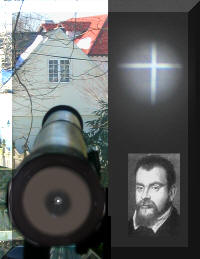 First
Light -- First test of the optics of our
replica.
The non Galileo real test was made using the Foucault knife
edge method First
Light -- First test of the optics of our
replica.
The non Galileo real test was made using the Foucault knife
edge method
Galileo's initial telescope work was toward
developing it as a weapon of war (the spy glass). He
traded rights of his design for a raise in salary and a
tenured position as, a teacher and research worker. Things
have not changed in 400 year. Today's Basic research
scientists go through the same struggle to get funding. The
chief role of the Hubble Telescope is for gathering data for
Star wars which has been one of the most important incentive
for today's astronomy, the mapping and studying of the
heavens so that we don't waste our anti- ballistic weapons
shooting at changes in the Orion's nebula, etc .
Galileo's first optical tests were probably similar to ours
(that is looking around the neighborhood with his high power
telescopes.
Our first image on the upper
right hand corner was taken through the telescope which is
in the lower left hand corner. (note the dot of light on the
ocular.) the image was the upper windows of a building
400ft. away.
We chose the cross hatch of
the window as a crude optical test chart giving us a day
time qualitative test of the optics.
It was only later that we
noticed that this image had the general appearance of a
Christian cross, symbolically ironic considering the
challenging relationship between Galileo and the Church.
This compelled us to slip in a picture of Galileo as he
probably looked when he made his famous discoveries while
exploring the heavens'
|
|
Building a museum grade
replica of Galileo's 400 years old telescopes has its
special considerations if one is to produce a high quality
replica which represents what it would have looked like new.
The telescopes as seen today have 400 years of
repairs, poorly documented modifications, inventory
errors that make it difficult to determine what they looked
like new. The authors believe that the best
replicating has to be done with seasoned experimental
scientists acquainted with the environment that
Galileo, his shop workers , and fellow scientist lived
and worked in. The replicator's
have to have a keen sense of working skills in each of the
steps necessary to make these early instruments as
accurately as possible including the original errors that
were built into the telescope. Said another way The builders
have to have considerable practical experience working as
experimental scientist to get the most likely answer to the
how and why questions that come up during the replication.
They are also absolutely essential when judging the
quality of the scientist who commissioned the instrument
and to those crafts-people who originally built
the instrument. In
making decisions during the replication of these telescopes
there were many questions searching for answers which we
needed
to achieve for a high level
of accuracy in making the replicas.
The
authors give you below a partial list but typical list
of questions we had to get answers for. |
Typical
questions that had to be answered in making a museum quality
replica of Galileo's telescopes.
- Should we make the telescope tube out
of cardboard as most replicators have done
to save time and cost or
use the stave type of construction
that we found while visiting the originals at the IMSS?.
- How accurate do we want the focal
length of the lenses to be and why? Special lens sizes
can cost hundreds of dollars compared to the $30
standard sizes? Galileo used a 980mm f.l. lens to days
standard is 1000mm.
- Is the present "add on" eyepiece and
its housing for the leather telescope represent orginal
equipment or a 1700 add on replacing a
plano-concave original?
- How much detail should we include in
the hot stamping dies and their application for the gold
embossing do we have to do to get it right? There
over 400 individual stampings each applied one at a time
as was done on the original.
How do we keep the cost under control in making the hot
stamped dies? Or do we use look almost alike dies?
- How close to the dimensions of the
existing telescopes should we build the replicas to?
- How much web space should we use
to explain why we have made these telescopes so exact
especially on parts no one will ever see?
- Should we bothered to cover the
reasons why double sided convex lens are used in the
drawing of Galileo optics yet the lenses
used were piano convex?
- Do we antique these telescopes or
not?
- Should we demonstrate what one
really observes looking through the telescope?
|
We have treated this website as a diary or rough journal
expressing our thoughts and actions not only as skilled trades
people but as senior scientist replicating these telescopes. We have attempted to cover every aspect in building
them including bits and pieces of the all important
background business
that
is seldom made available to the public.
Rule 1, We sense that these
instruments have a significant cultural
importance's therefore accuracy in replicating these
telescope is important if they are to taken seriously as
symbols of Galileo dramatic story, a very powerful, a
very important story that all of us need to pay attention
to.
Rule 2, Haphazardly put
together replicas would be insulting to the visitors, of
any museum, and to what
scientific community and science stands for. Mistakes
in any project happen but willfully miss leading people with bad data is not
tolerated in the scientific community.
Rule 3, We have
stayed away from the personalities, the family issues,
and the what, where, and when of
inventor-ship that some commercial and hobby
bio-authors dwell on sort of searching for a god like hero with clay feet . There is more than enough data to suggest that Gossipy
personal views
of Galileo- private life
which are mostly
guesses trivialize the importance of the Galileo story diverting us from the real issues which
are so important to all of us, the vigorous support needed by basic
scientific
research.
It saddens the authors when we read
critical comments about Galileo work from a reviewer
that has had little to no on hands experience in the
many roles that Galileo played throughout his technical
career. These authors muddy the waters so that few
really learn from this kind of writing what science
and engineering is all about.
We need to actively recognizes that we have to
help those in leadership roles to understand how Important
science and especially basic scientific research Is to each
of us and not to repeat the Galileo story over and over
again.
Galileo-s telescopes carry with
them very important examples of the religious political and
commercial trials and tribulations that our scientist
have to deal with
as part of their daily chores. These extracurricular duties
are created by
non scientist slowing down the
delivery of new valuable scientific
discoveries to us by leaders who find it difficult
to understand what science is all about. We allow these
leaders to slow down and deprive
all of us cures for costly
debilitating
illnesses. They slow down the discoveries that could bring
down the cost of
just living
a healthy satisfying
higher quality of life.
Because it is so very important, we
have included
our concerns for the future of science and its application
in
this country We
take note of the fantastic increase in life expectancy for
humans living in
technology-supporting countries and, on the other hand, the
shortening of the life of the planet and other livings things
as we have come to know
them are not political,
financial or religious issues they are
moral issues. We humans are
making dangerously
large changes in old mother earth.
|
